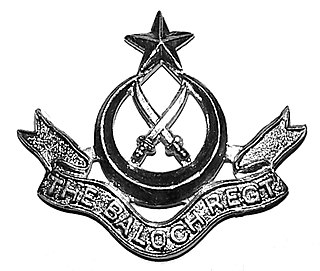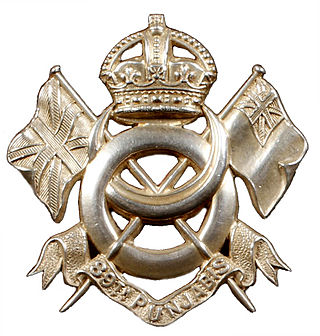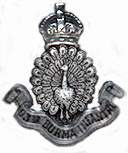
The Baloch Regiment is an infantry regiment of the Pakistan Army. The modern regiment was formed in May 1956 by the merger of 8th Punjab and Bahawalpur Regiments with the Baluch Regiment. Since then, further raisings have brought the strength of the Regiment to 27 battalions. The Baloch Regiment is descended from the infantry of the old British Indian Army and is named after Balochistan. Before 1991, it was called the Baluch Regiment but the spelling was changed to 'Baloch' to better reflect the correct pronunciation.

The 129th Duke of Connaught's Own Baluchis was an infantry regiment of the British Indian Army raised in 1846 as the 2nd Bellochee Battalion. It was designated as the 129th Duke of Connaught's Own Baluchis in 1903, and became 4th Battalion 10th Baluch Regiment in 1922. In 1947, it was allocated to Pakistan Army, where it continues to exist as 11th Battalion of The Baloch Regiment.

The 8th Punjab Regiment was a regiment of the British Indian Army from 1922 to 1947. It was transferred to Pakistan Army on Partition of India in 1947 and merged with the Baluch Regiment in 1956.

The 15th Lancers (Baloch) is an armoured regiment of the Pakistan Army. It was formed in 1922 by the amalgamation of the 17th Cavalry and the 37th Lancers (Baluch Horse).

The 10th Baluch or Baluch Regiment was a regiment of the British Indian Army from 1922 to 1947. After independence, it was transferred to the Pakistan Army. In 1956, it was amalgamated with the 8th Punjab and Bahawalpur Regiments. During more than a hundred years of military service, the 10th Baluch Regiment acquired a distinguished record amongst the regiments of the British Indian Army. Its list of honours and awards includes four Victoria Crosses.

The 89th Punjabis was an infantry regiment of the British Indian Army raised in 1798 as a battalion of Madras Native Infantry. It was designated as the 89th Punjabis in 1903 and became 1st Battalion 8th Punjab Regiment in 1922. In 1947, it was allocated to Pakistan Army, where it continues to exist as 1st Battalion, The Baloch Regiment.

The 90th Punjabis were an infantry regiment of the British Indian Army. The regiment was raised in 1799 as a battalion of Madras Native Infantry. It was designated as the 90th Punjabis in 1903 and became 2nd Battalion 8th Punjab Regiment in 1922. In 1947, it was allocated to Pakistan Army, where it continues to exist as 2nd Battalion of The Baloch Regiment.

The 91st Punjabis (Light Infantry) was an infantry regiment of the British Indian Army. The regiment was raised in 1800 as a battalion of Madras Native Infantry. It was designated as the 91st Punjabis in 1903 and became 3rd Battalion 8th Punjab Regiment in 1922. In 1947, it was allocated to Pakistan Army, where it continues to exist as 3rd Battalion of The Baloch Regiment.

The 92nd Punjabis were an infantry regiment of the British Indian Army. The regiment was raised in 1800 as a battalion of Madras Native Infantry. It was designated as the 92nd Punjabis in 1903 and became 4th Battalion 8th Punjab Regiment in 1922. In 1947, it was allocated to Pakistan Army, where it continues to exist as 4th Battalion of The Baloch Regiment.

The 93rd Burma Infantry was an infantry regiment of the British Indian Army. The regiment was raised in 1800 as a battalion of Madras Native Infantry. It was designated as the 93rd Burma Infantry in 1903 and became the 5th (Burma) Battalion 8th Punjab Regiment in 1922. In 1947, it was allocated to the Pakistan Army, where it continues to exist as 5th Battalion of The Baloch Regiment.

The 130th King George's Own Baluchis (Jacob's Rifles) was an infantry regiment of the British Indian Army raised in June 1858 as the 1st Belooch Rifles; re-designated as 1st Regiment Jacob's Rifles in September. It was designated as 130th Jacob's Baluchis in 1903 becoming 5th Battalion (King George's Own) 10th Baluch Regiment (Jacob's Rifles) in 1922. In 1947, it was allotted to Pakistan Army, where it continues to exist as 12th Battalion of The Baloch Regiment.
The 126th Baluchistan Infantry was an infantry regiment of the British Indian Army raised in 1825 as the 2nd Extra Battalion of Bombay Native Infantry. It was designated as the 126th Baluchistan Infantry in 1903 and became 2nd Battalion 10th Baluch Regiment in 1922. In 1947, it was allocated to the Pakistan Army, where it continues to exist as 7th Battalion of The Baloch Regiment.

The 124th Duchess of Connaught's Own Baluchistan Infantry was an infantry regiment of the British Indian Army raised in 1820 as the 2nd (Marine) Battalion 12th Regiment of Bombay Native Infantry. It was designated as the 124th Duchess of Connaught's Own Baluchistan Infantry in 1903 and became 1st Battalion 10th Baluch Regiment in 1922. In 1947, it was allocated to Pakistan Army, where it continues to exist as 6th Battalion of The Baloch Regiment.
The 26th Jacob's Mountain Battery was an artillery unit of the British Indian Army. The battery can trace its origins back to Golandauze Battalion (1826). In 1843 it became the 10th Company Golandauze Battalion of Bombay Foot Artillery, and became the 26th Jacob's Mountain Battery in 1903. In 1947, it was transferred to the Pakistan Army, where it exists as the 1st Jacob's Battery (Baloch) of The First (SP) Medium Regiment Artillery.

The Bahawalpur Regiment was a regiment of Pakistan Army. The regiment was formed in 1952 from the infantry battalions of the erstwhile Princely State of Bahawalpur, which had acceded to Pakistan in 1947. In 1956, the Bahawalpur Regiment was merged with the Pakistan Army
British East Africa 1896 is a Battle Honour awarded to the 24th (Baluchistan) Regiment of Bombay Infantry; an infantry battalion of the British Indian Army, which participated in the 1896 expedition to British East Africa to suppress a local rebellion.
British East Africa 1897–99 is a Battle Honour awarded to 27th Regiment of Bombay (Light) Infantry; an infantry battalion of the British Indian Army, which participated in the 1897 expedition to British East Africa to suppress a rebellion.

The 1st Battalion, Sindh Regiment is an infantry battalion of the Sindh Regiment of the Pakistan Army.
















